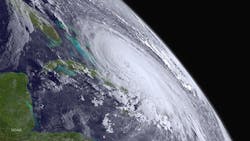UPDATED: Understanding Test Standards for Louvers in Hurricane-Prone Regions
Editor’s note: With the National Weather Service today reporting Hurricane Joaquin is gaining strength, with heavy rainfall and flash flooding possible for parts of the East Coast, regardless of track, HPAC Engineering is revisiting and updating this 2013 article.
In defined hurricane-prone regions, it is particularly important for building design engineers and owners/operators to understand test standards for building products. This article will discuss the basis of wind-speed and load, large-missile-impact, and wind-driven-rain requirements in the latest versions of the International Building Code (IBC) (2012) and Florida Building Code (FBC) (2010) relative to wall louvers.
Wind Speed and Load
IBC 2012 and FBC 2010 incorporate methods of determining wind speed and wind load found in ASCE/SEI 7-10, Minimum Design Loads for Buildings and Other Structures. These methods consider building risk, exposure, and height above grade.
Building risk. Buildings and structures are assigned one of four risk categories:
- Risk Category I, which indicates minimal economic or civilian-life impact in the event of failure.
- Risk Category II, which indicates mid-level economic or civilian-life impact in the event of failure.
- Risk Category III or IV, which indicates high economic or civilian-life impact in the event of failure.
Exposure. Exposure considers the location of a building or structure. If a building or structure is located in a metropolitan environment surrounded by other buildings or structures, the best-case Exposure B is assumed. If a building or structure is located with direct exposure to coastal waters or flat terrain without rough disruption, the worst-case Exposure D is assumed. For any other location, Exposure C is assumed.
Height above grade. Height above grade simply is how high a component or cladding is located on a building or structure. The higher a louver is located, the greater the impact on wind loading.
Following is a sampling of wind speeds and pressures for wall louvers in Miami calculated using ASCE/SEI 7-10:
- Ultimate design wind speed: 168 mph; building-risk category: II; exposure: B; height above grade: 20, 40, 60 ft; calculated wind pressure: 54, 59, 66 lb per square foot.
- Ultimate design wind speed: 168 mph; building-risk category: II; exposure: D; height above grade: 20, 40, 60 ft; calculated wind pressure: 84, 95, 101 lb per square foot.
- Ultimate design wind speed: 180 mph; building-risk category: III/IV; exposure: B; height above grade: 20, 40, 60 ft; calculated wind pressure: 62, 68, 76 lb per square foot.
- Ultimate design wind speed: 180 mph; building-risk category: III/IV; exposure: D; height above grade: 20, 40, 60 ft; calculated wind pressure: 96, 109, 116 lb per square foot.
Large-Missile Impact
IBC 2012 and FBC 2010 define wind-borne-debris region as any location within a hurricane-prone region where the ultimate design wind speed is 140 mph or greater or any location within one mile of the coastal mean high-water line within a hurricane-prone region where the ultimate design wind speed is 130 mph or greater.
IBC 2012 and FBC 2010 say louvers protecting intake and exhaust ventilation ducts not assumed to be open located within 30 ft of grade are to meet the requirements of ANSI/AMCA Standard 540, Test Method for Louvers Impacted by Wind Borne Debris, or, in the case of FBC 2010, be protected by an impact-resistant cover complying with an approved impact-resistance standard or the large-missile test of ASTM E1996, Standard Specification for Performance of Exterior Windows, Curtain Walls, Doors, and Impact Protective Systems Impacted by Windborne Debris in Hurricanes.
ANSI/AMCA Standard 540 is very similar in spirit to ASTM E1996 and FBC Testing Application Standard (TAS) 201, Impact Test Procedures. However, ANSI/AMCA Standard 540 requires manufacturers to test their smallest louver specimen, rather than their largest. (Passing a missile-impact test is more difficult with a smaller louver specimen.) Additionally, ANSI/AMCA Standard 540 has two different missile speeds to consider. For basic protection, Missile Level D, which simulates the impact of a 9-lb 2-by-4 traveling at a rate of 50 fps (34 mph), is required. For enhanced protection, which is required for all essential facilities, Missile Level E, which simulates the impact of a 9-lb 2-by-4 traveling at a rate of 80 fps (55 mph), is required.
High-Velocity Wind-Driven Rain
Both FBC 2010 and the 2012 International Mechanical Code (IMC) require compliance with ANSI/AMCA Standard 550, Test Method for High Velocity Wind Driven Rain Resistant Louvers, for louvers in hurricane-prone regions. While FBC 2010 requires compliance with ANSI/AMCA Standard 550 for both intake and exhaust louvers, IMC 2012 requires it only for intake louvers.
AMCA Standard 550 is very similar in spirit to FBC TAS 100, Test Procedure for Wind and Wind Driven Rain Resistance of Discontinuous Roof Systems. A fan in front of a 48-in.-by-48-in. louver simulates 35-, 70-, 90-, and 110-mph winds. Between the fan and louver are water spray nozzles, which simulate rain falling at a rate of 8.8 in. per hour. Thirty-five-, 70-, and 90-mph winds are simulated for 15 min each, while 110-mph wind is simulated for 5 min. The difference between AMCA Standard 550 and TAS 100 is the measure of pass or failure. TAS 100 allows zero water penetration during the 35- and 70-mph-wind simulations and only 0.05-percent water penetration during the 90- and 110-mph-wind simulations. AMCA Standard 550 allows up to 1-percent water penetration throughout the test.
Conclusion
Consult a local code official to determine the latest code requirements for your area. For adoptions of international codes by state, go to http://www.iccsafe.org/gr/documents/stateadoptions.pdf.
Andy Jackson is louver-product manager for Greenheck Fan Corp. He serves on the Air Movement and Control Association International Air Control Code Action and Review, Louver Engineering, 500-L (Laboratory Methods of Testing Louvers for Rating), 540 (Test Method for Louvers Impacted by Wind Borne Debris), and 550 (Test Method for High Velocity Wind Driven Rain Resistant Louvers) committees.

